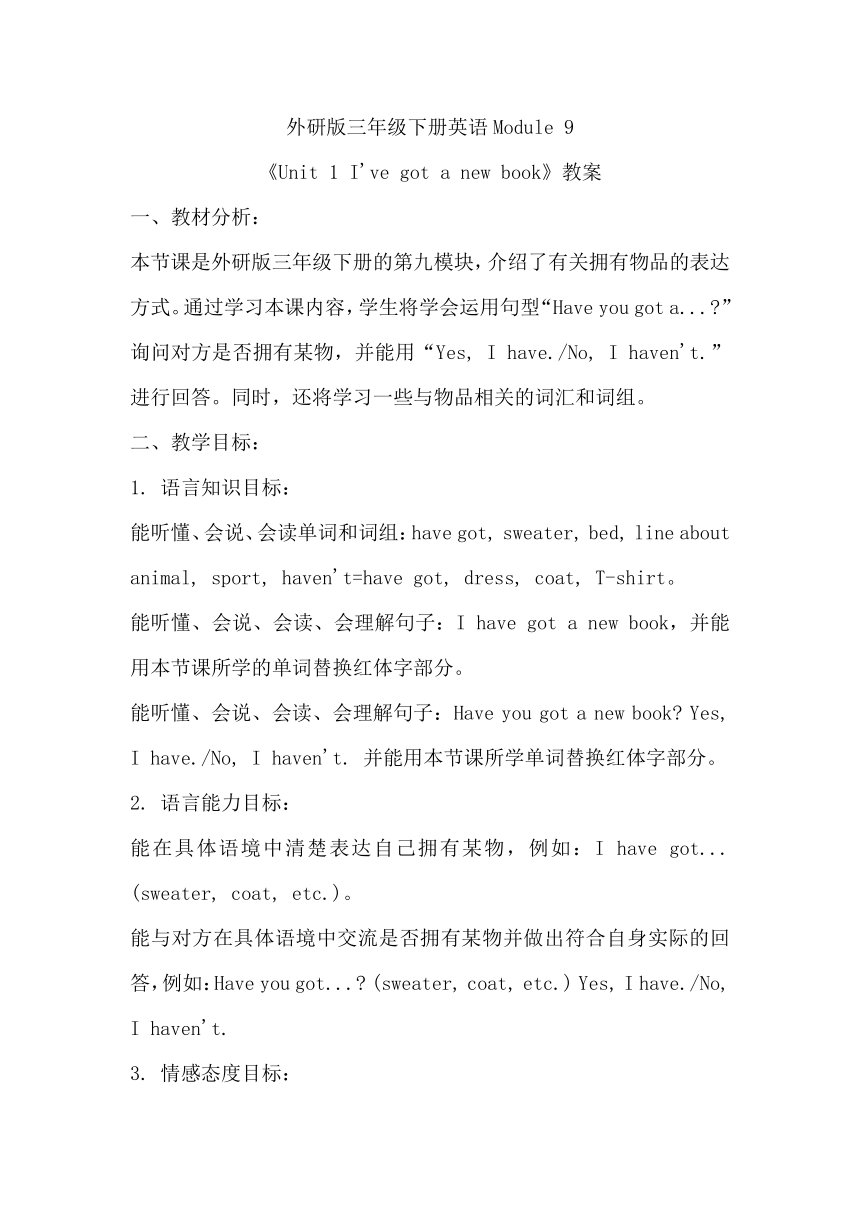
外研版三年级下册英语Module 9 《Unit 1 I've got a new book》教案 一、教材分析: 本节课是外研版三年级下册的第九模块,介绍了有关拥有物品的表达方式。通过学习本课内容,学生将学会运用句型“Have you got a... ”询问对方是否拥有某物,并能用“Yes, I have./No, I haven't.”进行回答。同时,还将学习一些与物品相关的词汇和词组。 二、教学目标: 1. 语言知识目标: 能听懂、会说、会读单词和词组:have got, sweater, bed, line about animal, sport, haven't=have got, dress, coat, T-shirt。 能听懂、会说、会读、会理解句子:I have got a new book,并能用本节课所学的单词替换红体字部分。 能听懂、会说、会读、会理解句子:Have you got a new book Yes, I have./No, I haven't. 并能用本节课所学单词替换红体字部分。 2. 语言能力目标: 能在具体语境中清楚表达自己拥有某物,例如:I have got... (sweater, coat, etc.)。 能与对方在具体语境中交流是否拥有某物并做出符合自身实际的回答,例如:Have you got... (sweater, coat, etc.) Yes, I have./No, I haven't. 3. 情感态度目标: 培养学生乐于用英语和朋友交流的习惯。 注意在交流过程中不要轻易打断别人的讲话。 三、教学重点和难点: 重点: 1. 听、说、认读本课的单词和词组。 2. 能清楚表达自己拥有某物。 3. 能口头运用“Have you got a book ”这类语句询问某人是否拥有某物,并能用“Yes, I have./No, I haven't.”回答。 难点: 能口头运用“Have you got a book ”这类语句询问某人是否拥有某物,并能根据自己的实际情况,用“Yes, I have./No, I haven't.”回答。 四、学情分析: 学生是三年级的学生,他们对于英语的学习充满了好奇和兴趣。他们已经学会了一些基本的英语单词和句型,并且能够用简单的英语与他人进行简单的交流。在学习过程中,他们喜欢通过游戏和互动的方式进行学习,并且能够积极参与课堂活动。 五、教学过程: Step 1: Warm-up 1. Greet the students and ask them how they are feeling today. Encourage them to respond with complete sentences, such as "I'm feeling happy/sad/excited today because..." 2. Play a quick game of "Simon Says" to review some body parts vocabulary. Give instructions like "Simon says touch your head/shoulder/knee/toe." Make sure to use both positive and negative instructions to challenge the students. Step 2: Presentation 1. Show a picture of a book and elicit the word "book" from the students. Write it on the board and emphasize the pronunciation. 2. Introduce the sentence pattern "I have got a new book" and explain its meaning. You can say, "When we want to talk about something we own or possess, we can use the sentence pattern 'I have got.' Today, we will use it to talk about new things we have." 3. Use gestures and facial expressions to convey the meaning of the sentence. For example, show excitement when saying "I have got a new book." Encourage the students to imitate your gestures and expressions. 4. Model the sentence and have the students repeat after you several times, focusing on correct pronunciation and intonation. 5. Show pictures of other objects (sweater, bed, etc.) and elicit the words from the students. Write the words on the board and make sure the students understand their meanings. 6. Model sentences using the new words, e.g., "I have got a new sweat ... ...
~~ 您好,已阅读到文档的结尾了 ~~